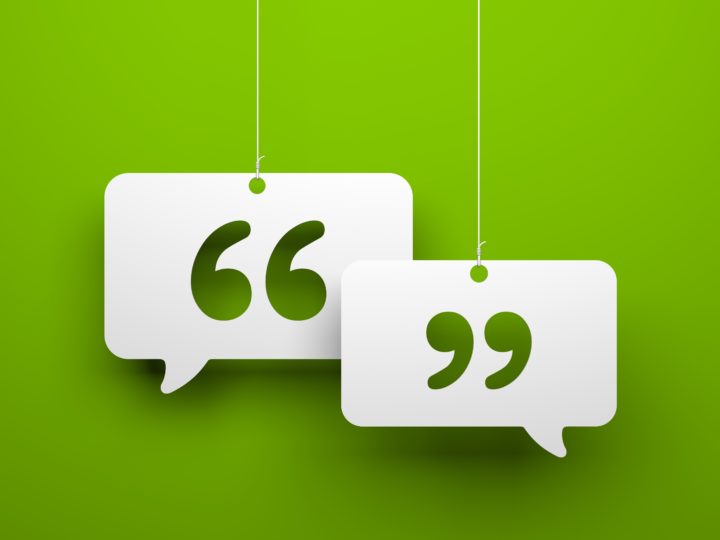When you’re selling a differentiated product or service, you need to think about it forward, but sell it backward.
Think forward
Think forward simply means that you figure out how it’s going to help your customer in a linear fashion going forward. First, you identify your differentiators, determine how they will impact the customer’s business operations and processes, and then calculate the business and financial benefit.
Differentiators
Brainstorm what sets you apart from competing alternatives, including status quo. But you need to take a broad view of your differentiators and consider your complete offering. Too many salespeople focus only on the actual product differentiators, which is why I often hear them bemoaning the fact that theirs is a commodity. To which I reply: there is no such thing as a commodity. If you consider things such as packaging, delivery reliability, financing, convenience, durability, consistency, contract terms, your company’s financial strength, customer service, order size, time to implement, training, you can always find at least one edge to cut into commodity thinking.
Process Impact
A differentiator is only relevant to the customer if it affects their ground level operations in some way, so the obvious question to ask about each differentiator is SO WHAT? Every business conducts operations and processes in order to deliver value to their customers, and they are always happy to consider ways to improve them. There are four general types of improvements you can make, all of which fall under the acronym POCR (I call them POCR chips): problems to be solved, opportunities to exploit, changes to adapt to, and risks to mitigate. In a sense, you’re figuring out the actual physical impact, which moves the needle of one or more important process metrics, such as time, labor, throughput, yield, quality, etc.
Business Impact
With the “So What?” figured out, the next two questions are “How much?” and “Who cares?”. In other words, what’s the business and financial impact and who benefits from those? Financial impacts broadly fall into three buckets: revenues, costs, and asset efficiency. Additional business impacts include risk reduction, strategic impact, and personal satisfaction. This is the language you need to be comfortable with when speaking at top decision making levels, and it’s especially important when you’re selling a solution that is new enough to make possible disruptive change.
Sell backward
Once you have the broad outlines of your value figured out, your selling task is to get the customer’s agreement about it. But you can’t do it in the same forward linear fashion, for two reasons. First, jaded customers tend to tune out of product-first pitches, so you’ll be on the wrong foot from the start. Second, your analysis probably has a lot of holes in it, because until you talk to a customer and understand their particular situation, you won’t have the actual numbers. By asking questions to fill in the numbers, you get the customer involved in your thinking process and end up with credible numbers.
The solution is to structure your conversation or presentation backwards. Start with a discussion of their business goals and needs, then work backwards to get agreement on the process changes they need to make to achieve those goals. Once you have that, that’s when you talk about the specific differentiator that makes it possible. The most effective structure for backwards selling is the standard story structure: situation, conflict, and resolution. If you’re delivering a presentation, it’s a great narrative structure to pull them along, or if it’s a dialogue, you can order your questions to get them to tell you the story you want them to hear.
As I’ve said before, leave the product in the car. The best possible outcome, and I know it’s possible because I’ve done it a few times myself, is when the customer agrees to do business—and you have not even talked about the product at all. That’s the beauty of thinking forward and selling backward.
I think my default writing style is reasonably conversational—until I put it to the test. Sometimes it sounds way different out loud than it looks on paper. This normally would not be a problem, because everyone expects writing to be a bit more formal. But there are times when it is critical that you should write for the ear and not the eye.
It’s especially important when you’re crafting a value proposition to start a sales call, or to leave a voice mail for a prospect that will get them to call you back. It’s not too hard to sound spontaneous, and it’s not too hard to sound clever, but trying to do both at once takes work. That work comprises three activities: thinking, writing, and saying.
Obviously, you need to start by thinking what the gist of your message is going to be. But a lot of salespeople stop right here. It sounds good in their head, so they’re confident they can wing it come showtime.
From my own long experience in personally botching unprepared statements plus coaching thousands of role plays, I’ve come to firmly believe in writing it down, because often you don’t know what you think until you try to write it out, and the process of writing and re-writing helps you refine and improve it. That’s where the clever part comes in.
The next step is to make it sound spontaneous. Why is spontaneity important? Because it’s more believable if it sounds natural and effortless. If it sounds like pre-prepared words read off a sheet of paper, you wonder if the speaker believes them himself. People want to feel like you’re talking to them, not at them.
So the third step is to test it by saying it out loud. Skip that step and you may run into a situation that once happened to me, when I called a sales VP at a prospect company to get an appointment. I gave him a beautifully written value proposition, with an exquisitely crafted sentence that contained a plethora of multisyllabic words, and then waited for his reply. After a few seconds of silence, he said, “I didn’t understand a word you just said.”
I think of that story every single time before I make a sales call, which is actually how I got the idea to write this post just now. Just a few minutes ago I prepared for a call to a prospect, and I wrote out a nice value proposition. Then I read it out loud, and the good news was, it didn’t completely stink. But then I said it again a few more times—not reading word for word, but repeating the sentiment, until it sounded both clever and spontaneous. Only then did I pick up the phone and make the call. I ended up leaving a voice mail, so I’m not claiming victory just yet, but at least I didn’t hang up the phone wishing I could go back and delete my own message!
Moderation is dead! The only way to be heard and to have any influence in today’s world is to use extreme rhetoric. Even if you aren’t comfortable with it, you can’t beat them so it’s urgent that you join them before you get crushed! We’re in a post-truth era, which means that you have to be as forceful and hyperbolic in your claims and expression, or you are guilty of persuasion malpractice. IF YOU AREN’T OUTRAGED, YOU’E NOT PAYING ATTENTION!
Now that I got that out of my system, let me start again by saying:
Judging from our current political climate, it would seem that the use of extreme rhetoric is on the rise. You might even think that it’s the only way to get heard, so you would be forgiven for being tempted to adjust your persuasive approach. Some say we’re in a post-truth era, in which outlandish claims don’t have to be true—as long as they work. That being so, if you’re moderate and measured you will only be ineffective on behalf of your side.
Here’s the problem: the second paragraph is more credible, but the first one grabbed your attention.
That’s why it has recently been common practice in our national discourse toward extreme claims and excessive fear mongering. The other side doesn’t just disagree with us, they hate us. Their policies aren’t just misguided, they will cause an irrevocable disaster. The world is falling apart, so we have to be as forceful as possible to save it.
After a while, you just get numb to it, so they ratchet up their rhetoric even more to get past your filters. When they cry wolf so often, the townspeople put on earmuffs and go on with their lives. The problem is that when a real wolf does appear, who will listen then?
I’m not sure anything can be done about it; I certainly don’t have any answers. But it’s critical to your credibility and influence in business that you don’t let it affect the way you sell your ideas.
In fairness, there are some benefits to making extreme claims. Forcefulness grabs attention, which is why talk shows keep inviting back hedgehog pundits even after they’re proven wrong. The fox who keeps saying “on the other hand”, is politely thanked and then promptly forgotten. Plus, if you think of a proposal or an argument as the start of a negotiation where both parties eventually meet in between opening positions, an extreme claim can set an anchor that will make you look reasonable when you back off. Finally, hedges and hesitations can act as “power leaks” that detract from the forcefulness of your speech.
Yet, in negotiation an extreme opening position risks chasing away the other party by insulting them or convincing them you’re not serious. Even if they don’t walk away, they will automatically consider anything that comes out of your mouth as a worst-case or best-case scenario, and will look for contradictory evidence. The biggest risk of an extreme position is that it can trap you: once you crawl out on that limb, you’re a “loser” if you try to come back to the middle.
And there is evidence that others find a moderate level of confidence more credible. In a study done for the legal profession testing mock juries, jurors found witnesses to be more credible when they were in the middle range of confidence about their testimony. In another study, it was seen that people who are already perceived as experts actually seem more credible when they hedge their opinions a bit; it makes them appear more thoughtful.
Another piece of evidence that moderate speech may be more persuasive is the Sarick Effect, which Adam Grant discusses in his book Originals. In effect, it’s the idea that bringing out the negatives of your own idea can paradoxically make it more attractive to others, because it lowers their defenses and makes you appear more honest, among other reasons. I would think that an audience grown cynical by extreme rhetoric would at least find it refreshing.[1]
On the other hand (there I go again) , it may depend on your audience. Research shows that in general, unsophisticated audiences prefer one-sided arguments, but sophisticated audiences prefer two-sided arguments.
Moderation isn’t just about how you say it; it’s also about fairly presenting evidence. Hans Rosling ,in his excellent new book Factfulness (which incidentally sparked my idea for this post), says that you should always present a mid-forecast with a range of possible scenarios, rather than simply selecting the most extreme position As he says, “This protects our reputations and means we never give people a reason to stop listening.”[2]
So, here’s my mid-forecast: go easy on the extreme rhetoric, use only credible data, and over the long term you will protecting your reputation and ensure others keep listening. And yes, I strongly believe that!
[1] Actually, Grant made up the tern “Sarick Effect”, to make a point about how familiarity makes things more believable. That’s a topic for an upcoming post.
[2] Factfulness, by Hans Rosling, Ola Rosling, and Anna Rosling Ronnlund, p. 231.
One of the best ways to add power and sparkle to your speech is to use an apt quotation.
As Brendan Behan said, “A quotation in a speech, article or book is like a rifle in the hands of an infantryman. It speaks with authority.” That “borrowed” authority from more accomplished and better-known experts is an excellent way to add power to your argument.
Quotations can also add sparkle and even a certain literary flair through the clever way they’re phrased. As Montaigne said, “I quote others only the better to express myself.”
But like any strong medicine, quotations need to come with a warning label. The first is that if you overuse them you may be perceived as not having your own point of view. As Dorothy L. Sayers said, “A facility for quotation covers the absence of original thought.”[1] Second, just like any medicine used past its expiration date may be ineffective or even harmful, many quotations have become clichés and have outlived their usefulness. Almost anything attributed (correctly or incorrectly) to Twain or Einstein falls into this category. Finally, just as some medicines need to be taken with food, any quotation you use should be a supplement to your own original point of view, not a substitute.
Here are a few additional tips to use quotations effectively:
- Make sure you quote them correctly and assign proper credit. If Einstein had said half the things people attribute to him, he never would have had time to think about relativity. It’s so easy to check quotations that you look lazy if you don’t.
- In you’re unfamiliar with the person who said it, look them up[2]. This may prevent embarrassment, as I suffered once when I quoted Konrad Lorenz and then found out that he was tainted by association with the Nazi party.
- Quote someone especially meaningful to your particular audience, such as their own company’s CEO or someone respected in their industry. I’ve had good success with highly technical audiences, for example, by quoting Richard Feynman.
- Dig a little deeper to go beyond the ones everyone already knows. Everyone has heard some variation of: “Sorry for sending such a long letter; I didn’t have time to write a short one,” but he also said: “NO CAN DO 2 PAGES TWO DAYS. CAN DO 30 PAGES 2 DAYS. NEED 30 DAYS TO DO 2 PAGES”.[3]
- When using them in a speech, keep them short, both so you don’t bore your audience and so you can memorize them and not have to read them off your screen. It’s OK to edit a long quotation as long as you don’t distort the original meaning.
[1] Normally I would not use so many quotations in one post, but it is about quotations…
[2] As I had to do for two of the quotes above. Brendan Behan was an Irish poet, and Dorothy Sayers an English crime writer and poet.
[3] In fairness, this one may be apocryphal.






